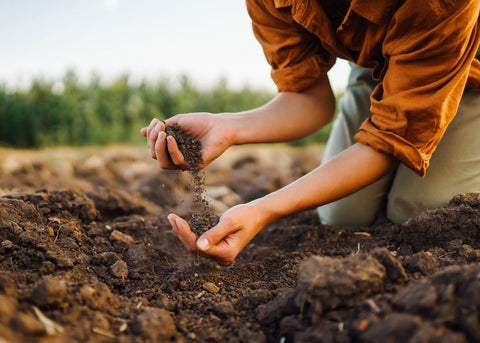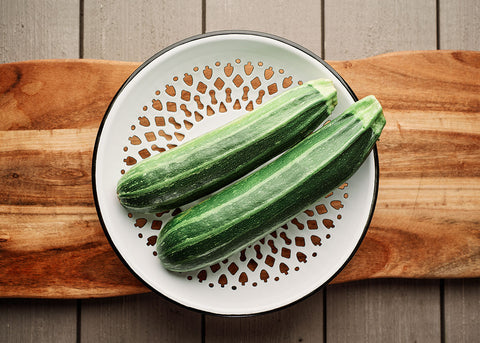In most cultures, whether ancient or modern, there is a certain dignity associated with tea time. Participants come to the tea table with a fancier cup, a better posture, a thesaurus and an anecdote. When it comes to the untapped potential for tea time, one really need not look any further than outside their kitchen window. We're talking about the herb garden, or more specifically, the “herbal tea garden”. Whether formal or a little more charismatic in growth pattern, there's something rustically charming and story-bookish about an herbal tea garden. The side effects of a thriving herbal tea garden are aplenty-- strong aesthetics, pollinating visitors galore, a symphony of scents, a sanctuary of calm.

The tea garden also brings to the table a wide range of medicinal potential for us. Bound by charity, the leaves, flowers, stems and roots of herbs will give some of their phyto-natural power to the waters surrounding it. Herbal tea has been used to promote good health since the time the extraction power of water was discovered. While a tea typically delivers a less-concentrated wealth of healing properties than, say, a tincture, it delivers nonetheless (i.e., if tinctures punch you back to health, teas pinch you back to health). When prepared and used appropriately, herbal teas may be a wonderful addition to your holistic healthcare toolbox and an easy way to balance and restore health every day. And while those store-foraged tea boxes are fine in a pinch, even better is a pinch of herbs plucked a few strides from your back door.
In this article we will discuss a small starter collection of familiar and well-studied herbs having varied flavors and abilities. We'll begin with a couple herbs that you may already associate with tea and then dive into some that you may not. A fun fact is that the majority of these herbs on this list are in the botanical family Lamiaceae, also known as "the mint" family. It's an herbal tea monopoly of sorts.
Note: this article is for informational purposes only and not meant to provide individualized medical advice. It is also not intended to be an all-encompassing guide (pages could be written on each herb). It is meant to stir up a resurgence in the medicinal herbal tea gardens of ol’ and inspire us to further personal research in the individual herbs and discussions with trained practitioners.
Chamomile (Matricaria chamomilla)

We can call this one "Calm-o-mile". In tea form, chamomile is a wonderful nervine relaxant. This faithful and gentle friend, whether of the German or Roman variety, is there for us when we need to step off the coffee-carousel and into a more relaxed mindset at work. It's there for us when we need to wind down after a long day and segue into our nighttime routine. The herbal peacemaker it is, it also wants to calm your stomach when it's in distress. And, when it's time to settle the kids down (any time of day), a lightly-sweetened chamomile tea will often do the trick. The kids will like the mellow flavor of this one, with its faint apple-and-honey notes. Tip: Pick the flower heads on the first day they open to get the active constituents at their strongest concentrations.
Echinacea (Echinacea purpurea)

Echinacea (or Purple Coneflower) is another herb with mainstream approval and appeal. Its beautiful flowers are known for their immune-supporting capabilities and pleasant floral flavor. This one should be in regular tea-time rotation during "sick season". Research shows that it has the ability to reduce inflammation and heighten the body's resistance to bacterial and viral infections, such as the common cold and flu, as well as help ease the symptoms of these infections. They say familiarity breeds contempt, but in this case trust that the familiarity of echinacea means it's been doing something right for a long time and we all know it. Tip: Add ginger and holy basil to this tea for a spicier counterpunch and an even stronger armor against those mischievous microbes.
Thyme (Thymus vulgaris)

Thyme Tea at Tea Time? Seussalogically speaking it makes perfect sense. Medicinally-speaking it's quite sensible, as well. There are records of thyme being used as a food preservative and infection remedy since ancient times. Thymol, a prime component of the thyme plant, is an active ingredient in a wide range of modern pesticidal and germicidal products used in industry and at home. It seems thyme just has a knack for keeping the bad guys at bay. The herbal sniper, if you will. In addition to antibacterial, antifungal, and antiseptic, Thyme's resume of herbal actions includes sedative, antioxidative, expectorant, antispasmodic, antihelminthic, carminative and diaphoretic effects. In tea form, its strengths are in supporting immune and inflammatory responses, fighting respiratory infections, clearing the sinuses and air passages, and expediting the healing of sore throats. In summary: it's prime time to make thyme tea part of your tea time. Tip: take a moment to breathe in the aromatic steam from the tea to quicken clearance of air passages.
Sage (Salvia officinalis)

Here's a medieval saying: "Why should a man die while sage grows in his garden?" Hyperbolic perhaps, yet clearly indicative of the healing nature of this herb. After all, its genus name is Salvia, which is Latin for "to heal" or "to save". That's quite a name to live up to and sage certainly tries its best. As a tea, sage acts as an antioxidant, antiseptic, and astringent. Drinking regularly (and gargling) while having mouth or throat sores may improve the condition. Sage tea also has estrogenic activity and helps relieve menopausal symptoms, such as hot flashes and dizziness. Next time any of these problems pose a threat, grab a sprig of Salvia officinalis. That's some sage advice right there. Tip: for more potent flavor and healing potential in your sage tea, steep the leaves for 30 minutes, or even longer.
Basil (Ocimum basilicum)

In general, the idea of a tea made with basil is likely to raise eyebrows. No one will question your wisdom if you drop some Genevise basil on pasta and pizza. Or drop some Thai basil on your coconut curry. But dropping basil in hot water during tea time? Eyebrows up. Basil comes in many forms and just about all of them will make an interesting tea. Some may be more tea-apparent, like cinnamon basil, lemon basil, chocolate basil-- but all deliver healing properties worth noting. Basil acts on the digestive system, easing flatulence, stomach cramps, colic and indigestion. It can help prevent nausea and vomiting and, with its mild anthelmintic herbal action, may assist in cleaning out any intestinal worms. Basil also has a mildly sedative action, proving useful for treating nervous irritability and anxiety. Tip: Up the ante by trying Holy Basil (or Tulsi) tea. While this is a different species (Ocimum tenuiflorum) than the other basils, it is closely related and is a revered medicinal herb used for tea around the world.
Hyssop (Hyssopus officinadis)

Hyssop is legendary in the world of holistic medicine. There's an old saying "Whoever rivals hyssop's virtues, knows too much". Pedanius Dioscorides, an ancient Greek physician, pharmacologist, botanist and author of De materia medica, a 5-volume Greek encyclopedia about herbal medicine, made his famous respiratory health tea with hyssop, rue, figs and honey. With antibacterial, diaphoretic (perspiration-promoter) and expectorant herbal actions, it should not be a surprise that Dioscorides' hyssop tea helped relieve common cold and flu symptoms, from sore throat and stuffy nose to difficulty breathing and chest congestion to high fever. More recent research (and historical usage) supports that it may be an effective treatment for urinary tract infections. With its ability to increase blood circulation and bile production, hyssop tea wants a say when it comes to your circulatory and digestive system health, as well. We can see why hyssop was once revered as a virtual cure-all. Tip: don't confuse hyssop (Hyssopus officinadis) with anise hyssop (Agastache foeniculum), as they are distinct species; that said, the latter should definitely also be invited to your next herbal tea party.
Lavender (Lavandula angustifolia)

Some of us have relegated lavender to the bathroom. Soaps and cleaners and poo candles. After all, the Latin root of lavender means “to wash”. However, you are slow to the party if you haven’t already built a bridge from bathroom to kitchen. The same pleasant and calm smell that makes for a clean bathroom can play a role in a healthy body. Like chamomile, lavender is a nervine relaxant, bringing you a sense of calm. Its anti-inflammatory and antimicrobial properties play a role in supporting the immune system and respiratory system during times of infection. With antispasmodic and cholagogue (bile flow stimulator) herbal actions, it is excellent at supporting the digestive system. It also boosts the production of dopamine and reduces the cortisol stress hormone. Lavender tea boasts a distinctive flavor and aromatic fragrance, with shades of rosemary and mint. Tip: enjoy a lavender tea an hour before bedtime, as studies have shown that lavender increases deep slow-wave sleep, which is considered the restorative sleep phase.
Rosemary (Salvia rosmarinus)

Believe it or not, this fragrant evergreen is in the same family as basil, thyme, lavender, hyssop and sage. If the Lamiaceae family were in the tea business for the money, they'd be making a mint. Thankfully this generous family freely shares from its vast collection of tasty and fragrant offerings. Rosemary has a distinct scent and flavor from among its siblings and cousins, which you surely would recognize if you have ever put your nose to the bush or eaten a sprig. This potent essence speaks to its abilities as a pick-me-up tea, able to help you escape from a case of the malaise. Rosemary tea is also an excellent circulatory stimulant, especially to the head region. In doing so, it helps improve memory and concentration, while easing headaches and migraines. Tip: pour the leftover tea on your head; no, really-- when rubbed into the scalp, it is said to encourage hair growth.
Dill (Anethum graveolens)

Dill: in appearance full of grace, in your mouth full of taste– just like its relatives, the carrot and fennel. "Dill" is believed to be a derivation of an old Anglo-Saxon word meaning "to soothe". The Latin name for the genus Anethum comes from a Greek word meaning "strong-smelling". This etymological combo aptly describes dill tea-- in your face but with only good intentions (especially once it gets to your stomach). Yes, the same phytochemicals in dill that help keep pickles fresh also act as a digestive tonic in your body. Both the leaves and seeds have been used with great success as a digestive aid for centuries. Its warming properties soothe digestion and help relieve gas and colic. Dill tea can also play a role in hormonal balancing, supporting both menstruation and lactation, while soothing uterine muscles and reducing the levels of stress that lead to painful cramps. It may not be a panacea for all that ails you, but if you find yourself in a pickle and need a health boost-- a little dill in tea could be a big deal to thee. Tip: use the leftover tea as a mouthwash, as the antibacterial properties of dill may help to reduce plaque and gingivitis and the antioxidants in dill tea can help to protect teeth and gums from damage.
Red Clover (Trifolium pratense)

Like peas and beans, red clover belongs to the family of plants called legumes. With its beautiful deep-pink pom-pom flower, you may opt to plant a red clover patch right in your tea garden-- for yourself and the pollinators who love it. Or you may opt to take advantage of its nitrogen-fixing power as a cover crop in your veggie garden beds. Or perhaps you want to just let nature (or the local farmer) do all the work and harvest it from a nearby field, park or roadside. Whatever your source may be, it's a fine idea to ensure red clover makes its way to your herbal tea cabinet. Historically used as an lymphatic and alterative herb (encouraging clearance of metabolic waste and tonifying those supporting systems) and an anti-catarrhal herb (reducing mucus-formation in sinuses), it may be more prominently known in our modern era for its phytoestrogenic activity. With its relatively high level of isoflavones, it has been shown to have therapeutic use for menopausal women and others dealing with low estrogen levels, and in breast cancer prevention and treatment. Tip: if you don't want red clover to spread beyond your tea garden, remember to remove the flower heads before they go to seed (and dry them for tea!).
Conclusion
An herbal tea garden guarantees a big return on the investment-- for health, for aesthetics, for pollinators, and for hospitality and the preservation of tea-time dignity. If you have a small yard, no problem. A basic herbal tea garden footprint need not be big and can even be accomplished via containers on the patio or deck, as long as there is adequate sun exposure. If you are a busy person, no problem-- focus on perennial herbs that require less routine maintenance (but never be too busy for teatime). And, for you pleasure-seeking visionaries who wish to engage all senses at once, establish a tea-time nook right in the midst of the sights, sounds, smells and textures of the garden. The best time to start planting your storybook medicinal herb tea garden is early spring. The second-best time is now. You will be rewarded.




